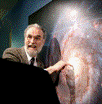Department of Physics and Astronomy: Publications and Other Research

C. Martin Gaskell Publications
Document Type
Article
Date of this Version
11-1-2007
Abstract
We consider in detail the spectral energy distribution (SED) and multi-wavelength variability of NGC 5548. Comparison with the SEDs of other AGNs implies that the internal reddening of NGC 5548 is E(B-V) = 0.17 mag. The extinction curve is consistent with the mean curve of other AGNs found by Gaskell & Benker, but inconsistent with an SMC-type reddening curve. Because most IR emission originates exterior to the broad-line region (BLR), the SED seen by the inner BLR is different from that seen by the outer BLR and from the earth. The most likely BLR covering factor is ~ 40% and it is not possible to get an overall BLR covering factor of less than 20%. This requires that the BLR is not spherically symmetric and that we are viewing through a hole. Line-continuum variability transfer functions are consistent with this geometry. The covering factor and geometry imply that near the equatorial plane the BLR covering approaches 100%. The spectrum seen by the outer regions of the BLR and by the torus is thus modified by the absorption in the inner BLR. This shielding solves the problem of observed BLR ionization stratification being much greater than implied by photoionization models. The BLR obscuration also removes the problem of the torus covering factor being greater than the BLR covering factor, and gives consistency with the observed fraction of obscured AGNs. The flux reduction at the torus also reduces the problem of AGN dust-reverberation lags giving sizes smaller than the dust-sublimation radii.


Comments
Published in Astrophysical Journal. Copyright © 2007 AAS. Used by permission.